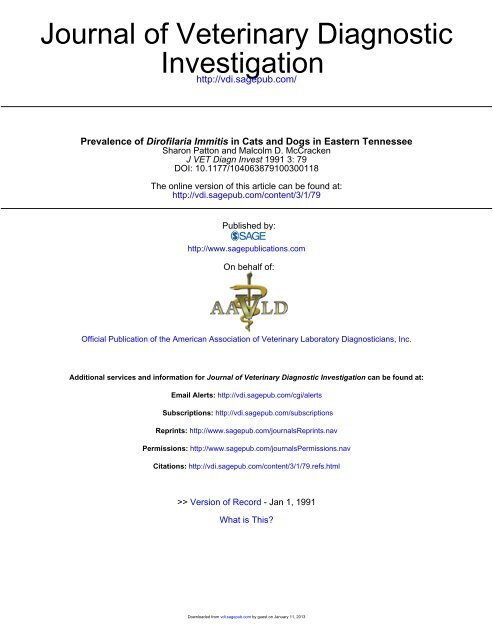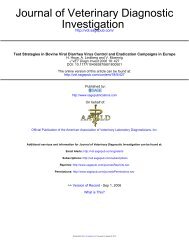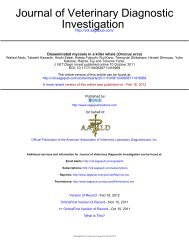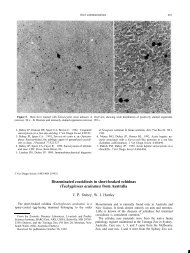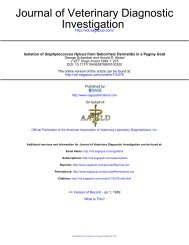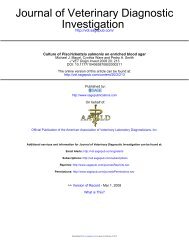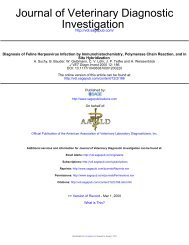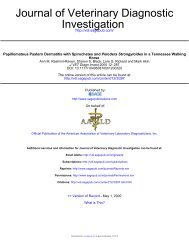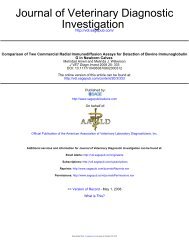Prevalence Of Dirofilaria Immitis In Cats And Dogs - Journal of ...
Prevalence Of Dirofilaria Immitis In Cats And Dogs - Journal of ...
Prevalence Of Dirofilaria Immitis In Cats And Dogs - Journal of ...
Create successful ePaper yourself
Turn your PDF publications into a flip-book with our unique Google optimized e-Paper software.
<strong>Journal</strong> <strong>of</strong> Veterinary Diagnostic<br />
<strong>In</strong>vestigation<br />
http://vdi.sagepub.com/<br />
<strong>Prevalence</strong> <strong>of</strong> <strong>Dir<strong>of</strong>ilaria</strong> <strong>Immitis</strong> in <strong>Cats</strong> and <strong>Dogs</strong> in Eastern Tennessee<br />
Sharon Patton and Malcolm D. McCracken<br />
J VET Diagn <strong>In</strong>vest 1991 3: 79<br />
DOI: 10.1177/104063879100300118<br />
The online version <strong>of</strong> this article can be found at:<br />
http://vdi.sagepub.com/content/3/1/79<br />
Published by:<br />
http://www.sagepublications.com<br />
On behalf <strong>of</strong>:<br />
<strong>Of</strong>ficial Publication <strong>of</strong> the American Association <strong>of</strong> Veterinary Laboratory Diagnosticians, <strong>In</strong>c.<br />
Additional services and information for <strong>Journal</strong> <strong>of</strong> Veterinary Diagnostic <strong>In</strong>vestigation can be found at:<br />
Email Alerts: http://vdi.sagepub.com/cgi/alerts<br />
Subscriptions: http://vdi.sagepub.com/subscriptions<br />
Reprints: http://www.sagepub.com/journalsReprints.nav<br />
Permissions: http://www.sagepub.com/journalsPermissions.nav<br />
Citations: http://vdi.sagepub.com/content/3/1/79.refs.html<br />
>> Version <strong>of</strong> Record - Jan 1, 1991<br />
What is This?<br />
Downloaded from<br />
vdi.sagepub.com by guest on January 11, 2013
Examination <strong>of</strong> raccoon feces from hayl<strong>of</strong>ts in Ontario has<br />
usually revealed large numbers <strong>of</strong> B. procyonis eggs (Lautenslager<br />
P, personal communication). Treatment <strong>of</strong> infected<br />
animals with various anthelminthics including thiabendazole,<br />
fenbendazole, levamisole, and ivermectin has not been<br />
effective. 2<br />
Brief communications 79<br />
References<br />
1. Fox AS, Kazacos RR, Gould NS, et al.: 1985, Fatal eosinophilic<br />
meninogoencephalitis and visceral larva migrans caused by the<br />
raccoon ascarid Baylisascaris procyonis. N Engl J Med 312:1619-<br />
1623.<br />
2. Kazacos RR, Boyce WM: 1989, Baylisascaris larva migrans. J<br />
Outbreaks similar to the 1 reported here will continue to Am Vet Med Assoc 195:894-903.<br />
occur as raccoons become more common as pets and coexist 3. Kazacos RR, Reed WM, Kazacos EA, Thacker HL: 1983, Fatal<br />
with human beings in urban and rural areas. It is important cerebrospinal disease caused by Baylisascaris procyonis in dothat<br />
physicians, public health <strong>of</strong>ficials, veterinarians, and the mestic rabbits. J Am Vet Med Assoc 183:967-971.<br />
general public be made aware <strong>of</strong> the Zoonotic potential and<br />
take necessary precautions when handling or harboring raccoons.<br />
4. Richter CB, Kradel DC: 1964, Cerebrospinal nematodosis in<br />
Pennsylvania groundhogs (Marmota monax). Am J Vet Res 25:<br />
1230-1235.<br />
J Vet Diagn <strong>In</strong>vest 3:79-80 (1991)<br />
<strong>Prevalence</strong> <strong>of</strong> <strong>Dir<strong>of</strong>ilaria</strong> immitis in cats and dogs in eastern Tennessee<br />
Sharon Patton, Malcolm D. McCracken<br />
The heartworm, DiroJilaria immitis, is enzootic in dogs in<br />
the United States. Diagnostic tests for heartworm disease are<br />
usually included in the evaluation <strong>of</strong> dogs presented with<br />
respiratory insufficiency, chronic cough, and exercise intolerance.<br />
Heartworm disease in cats is not as common as it is<br />
in dogs, but an increasing number <strong>of</strong> cases are reported each<br />
year. Currently, infection with D. immitis is usually included<br />
in the differential diagnosis <strong>of</strong> cats with coughing, dyspnea,<br />
or intermittent vomition. 2,4-8,14<br />
The frequency <strong>of</strong> heartworm<br />
infection in cats in a particular location correlates with that<br />
in the dog population but at a lower incidence. 13<br />
The objective<br />
<strong>of</strong> this study was to determine the prevalence <strong>of</strong> heartworms<br />
in dogs and cats in eastern Tennessee based on the<br />
Knott’s concentration technique for micr<strong>of</strong>ilariae and the<br />
enzyme-linked immunosorbent assay (ELISA) for antigen <strong>of</strong><br />
adult heartworms.<br />
Two populations were examined: (1) dogs and cats brought<br />
to the small animal clinic at the University <strong>of</strong> Tennessee,<br />
College <strong>of</strong> Veterinary Medicine (VTCVM) and (2) stray dogs<br />
and cats from random sources. Blood was collected from the<br />
dogs in the clinic as part <strong>of</strong> the routine physical examination<br />
and from both dogs and cats with signs <strong>of</strong> heartworm disease.<br />
All samples were collected and examined between November<br />
1985 and February 1990. The diagnosis <strong>of</strong> heartworms was<br />
based on the presence <strong>of</strong> D. immitis micr<strong>of</strong>ilariae in blood<br />
examined by Knott’s concentration technique or by the presence<br />
<strong>of</strong> antigen <strong>of</strong> adult heartworms detected in the serum<br />
with a commercial ELISA kit. a<br />
tests. The results <strong>of</strong> the Knott’s tests and the ELISA tests for<br />
D. immitis antigen for both dogs and cats are shown in Table<br />
1. From the clinic population, 1/23 cats (4.35%) and 135/<br />
2,658 dogs (5.08%) had circulating D. immitis micr<strong>of</strong>ilariae;<br />
93/673 dogs (13.82%) and 9/95 cats (9.47%) were positive<br />
for heartworm antigen. <strong>In</strong> the stray dog population, 78/950<br />
(8.2 1%) were positive for D. immitis. No D. immitis micr<strong>of</strong>ilariae<br />
were found in 122 stray cats examined, although 3<br />
(2.5%) <strong>of</strong> the cats had 1 adult female worm in the right<br />
ventricle. One <strong>of</strong> the cats with an immature female worm in<br />
the heart was positive for D. immitis antigen. All the other<br />
stray cats, including the 2 with adult D. immitis, were negative<br />
for D. immitis antigen.<br />
Other reports have indicated that ELISA tests for D. immitis<br />
antigen in cats are more likely to give a false negative<br />
than a false positive result.<br />
When the stray cats in the<br />
study were euthanitized by an animal shelter, they were necropsied<br />
and examined for D. immitis in the heart or other<br />
areas <strong>of</strong> the body to validate the usefulness <strong>of</strong> the diagnostic<br />
From the Department <strong>of</strong> Pathobiology, College <strong>of</strong> Veterinary<br />
Medicine, University <strong>of</strong> Tennessee, Knoxville, TN 37901- 1071.<br />
Received for publication April 2, 1990.<br />
1,3,11<br />
As in our study, when
80 Brief communications<br />
Table 1. <strong>Prevalence</strong> <strong>of</strong> <strong>Dir<strong>of</strong>ilaria</strong> immitis in dogs and cats in<br />
eastern Tennessee based on the presence <strong>of</strong> micr<strong>of</strong>ilariae and D.<br />
immitis antigen.<br />
This study shows that the frequency <strong>of</strong> infection with D.<br />
immitis in cats in eastern Tennessee is similar to the frequency<br />
<strong>of</strong> infection in dogs. However, the sick cats studied<br />
are not representative <strong>of</strong> the general cat population. The data<br />
from the dogs may be more representative because dogs examined<br />
at the UTCVM are routinely screened for heartworms<br />
rather than only when disease is obvious. Immunodiagnostic<br />
tests that detect adult D. immitis antigen are<br />
valuable adjuncts in heartworm diagnosis, particularly in cats<br />
where the infection is usually amicr<strong>of</strong>ilaremic. 2,9,10,15<br />
However,<br />
these tests lack sensitivity and false negatives occur.<br />
For an accurate diagnosis, the results <strong>of</strong> the antigen test should<br />
be considered with the evaluation <strong>of</strong> clinical signs, physical<br />
examinations, fecal examinations, tracheal washes, complete<br />
blood counts, electrocardiograms, and radiologic findings.<br />
Sources and manufacturers<br />
a. ClinEase/Dirochek Canine Heartworm Antigen Test Kit, Synbiotics<br />
Corp., San Diego, CA.<br />
References<br />
1. Brunner CJ, Hendrix CM, Blagbum BL, Hanrahan LA: 1988,<br />
Comparison <strong>of</strong> serologic tests for detection <strong>of</strong> antigen in canine<br />
heartworm infections. J Am Vet Med Assoc 192:1423-1427.<br />
J Vet Diagn <strong>In</strong>vest 3:80-81 (199 1)<br />
2. Calvert CA, Mandrel1 CP: 1982, Diagnosis and management<br />
<strong>of</strong> feline heartworm disease. J Am Vet Med Assoc 180:550-<br />
552.<br />
3. Courtney CH: 1986, Comparison <strong>of</strong> tests for immunodiagnosis<br />
<strong>of</strong> canine dir<strong>of</strong>ilariasis. <strong>In</strong>: Proc Heartworm Symp, ed. Otto GF,<br />
pp. 77-82. American Heartworm Society, Washington, DC.<br />
4. Dillon R: 1983, Feline heartworm disease: clinical evaluation.<br />
<strong>In</strong>: Proc Heartworm Symp, ed. Otto GF, pp. 31-33. VM Publishing,<br />
Bonner Springs, KS.<br />
5. Dillon R: 1986, Feline heartworm disease. <strong>In</strong>: Proc Heartworm<br />
Symp, ed. Otto GF, pp. 149-154. American Heartworm Society,<br />
Washington, DC.<br />
6. Dillon R: 1988, Feline heartworm disease. <strong>In</strong>: <strong>Dir<strong>of</strong>ilaria</strong>sis,<br />
ed. Boreham PFL, Atwell RB, pp. 205-215. CRC Press, Boca<br />
Raton, FL.<br />
7. Dillon R: 1989, Clinical presentation and diagnosis <strong>of</strong> feline<br />
heartworm disease. Calif Vet 43(special ed.):33-3 5, 38.<br />
8. Dillon R: 1989, Clinical management <strong>of</strong> feline heartworm disease.<br />
Calif Vet 43(special ed.):36-37.<br />
9. Donahoe JMR: 1974, Clinical aspects <strong>of</strong> feline dir<strong>of</strong>ilariasis.<br />
<strong>In</strong>: Proc Heartworm Symp, ed. Morgan HC, pp. 59-65. VM<br />
Publishing, Bonner Springs, KS.<br />
10. Donahoe JMR: 1975, Experimental infection <strong>of</strong> cats with <strong>Dir<strong>of</strong>ilaria</strong><br />
immitis. J Parasitol 61:599-605.<br />
11. Dzimiznski MT, McCall JW, McCall CA: 1986, Evaluation <strong>of</strong><br />
heartworm immunodiagnostic test kits using well defined cat<br />
sera. <strong>In</strong>: Proc Heartworm Symp, ed. Otto GF, pp. 159-161.<br />
American Heartworm Society, Washington, DC.<br />
12. Lok JB: 1988, <strong>Dir<strong>of</strong>ilaria</strong> sp. Taxonomy and distribution. <strong>In</strong>:<br />
<strong>Dir<strong>of</strong>ilaria</strong>sis, ed. Boreham PFL, Atwell RB, pp. l-28. CRC<br />
Press, Boca Raton, FL.<br />
13. Otto GF: 1975, Occurrence <strong>of</strong> the heartworm in unusual locations.<br />
<strong>In</strong>: Proc Heartworm Symp, ed. Morgan HC, pp. 6-l 3.<br />
VM Publishing, Bonner Springs, KS.<br />
14. Rawlings CA: 1986, Heartworm disease in cats. <strong>In</strong>: Heartworm<br />
disease in dogs and cats, ed. Rawlings CA, pp. 295-310. W. B.<br />
Saunders Co., Philadelphia, PA.<br />
15. Wong MM: 1982, <strong>Dir<strong>of</strong>ilaria</strong>sis in cats. J Am Anim Hosp Assoc<br />
19:855-864.<br />
Pancreatic fibrosis associated with zinc toxicosis in a dog<br />
Daniel P. Shaw, James E. Collins, Michael J. Murphy<br />
A 13-year-old mixed breed female dog <strong>of</strong> unknown vaccination<br />
status was found dead in the kennel after 5 days <strong>of</strong><br />
lethargy, poor appetite, and weight loss. Antemortem clinical<br />
examination had not been attempted.<br />
During necropsy, marked icterus was found. The pancreas<br />
From the Department <strong>of</strong> Veterinary Diagnostic <strong>In</strong>vestigation, College<br />
<strong>of</strong> Veterinary Medicine, University <strong>of</strong> Minnesota, 1943 Carter<br />
Avenue, St. Paul, MN 55108.<br />
Received for publication July 18, 1990.<br />
Downloaded from<br />
vdi.sagepub.com by guest on January 11, 2013<br />
was firm and coarsely nodular. A partially dissolved penny<br />
was lodged in the pyloric antrum <strong>of</strong> the stomach. The spleen<br />
was moderately enlarged and dark red. No other gross changes<br />
were identified.<br />
Microscopically, there was severe interstitial fibrosis in the<br />
pancreas, which caused accentuation <strong>of</strong> the lobular pattern<br />
(Fig. 1). There was infiltration <strong>of</strong> the fibrotic interstitium by<br />
moderate numbers <strong>of</strong> lymphocytes and macrophages. Many<br />
<strong>of</strong> the acini <strong>of</strong> the exocrine pancreas were distorted due to<br />
periacinar fibroplasia. The nuclei <strong>of</strong> the acinar cells were


